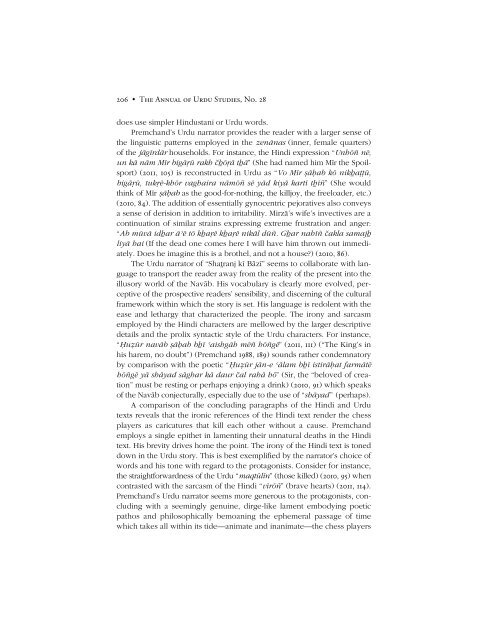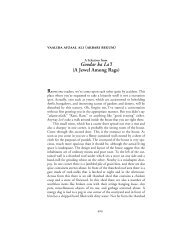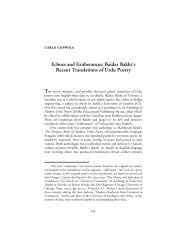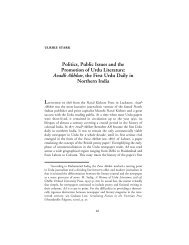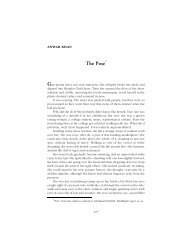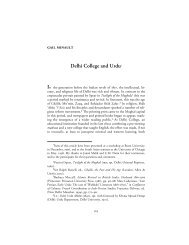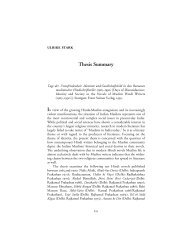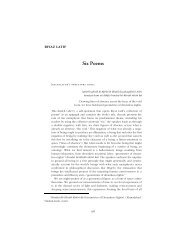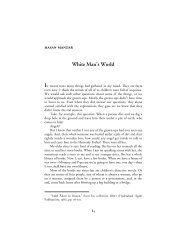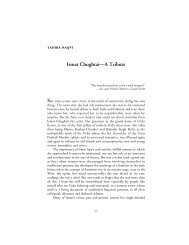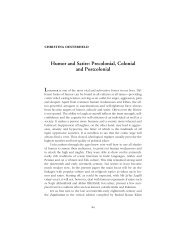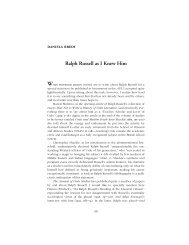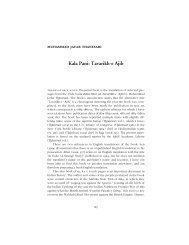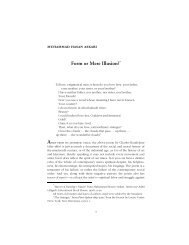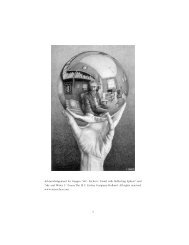Premchand's âShatranj ke Khilariâ in Translation - the Annual of Urdu ...
Premchand's âShatranj ke Khilariâ in Translation - the Annual of Urdu ...
Premchand's âShatranj ke Khilariâ in Translation - the Annual of Urdu ...
Create successful ePaper yourself
Turn your PDF publications into a flip-book with our unique Google optimized e-Paper software.
206 • The <strong>Annual</strong> <strong>of</strong> <strong>Urdu</strong> Studies, No. 28<br />
does use simpler H<strong>in</strong>dustani or <strong>Urdu</strong> words.<br />
Premchandís <strong>Urdu</strong> narrator provides <strong>the</strong> reader with a larger sense <strong>of</strong><br />
<strong>the</strong> l<strong>in</strong>guistic patterns employed <strong>in</strong> <strong>the</strong> zenānas (<strong>in</strong>ner, female quarters)<br />
<strong>of</strong> <strong>the</strong> jāgīrdār households. For <strong>in</strong>stance, <strong>the</strong> H<strong>in</strong>di expression ìUnhōñ nē,<br />
un kā nām Mīr bigāṛū rakh čẖōṛā tẖāî (She had named him Mīr <strong>the</strong> Spoilsport)<br />
(2011, 105) is reconstructed <strong>in</strong> <strong>Urdu</strong> as ìVo Mīr ṣāḥab kō nikẖaÅÅū,<br />
bigāṛū, tukṛē-khōr vaghaira nāmōñ sē yād kiyā kartī tẖīñî (She would<br />
th<strong>in</strong>k <strong>of</strong> Mīr ṣāḥab as <strong>the</strong> good-for-noth<strong>in</strong>g, <strong>the</strong> killjoy, <strong>the</strong> freeloader, etc.)<br />
(2010, 84). The addition <strong>of</strong> essentially gynocentric pejoratives also conveys<br />
a sense <strong>of</strong> derision <strong>in</strong> addition to irritability. Mirzāís wifeís <strong>in</strong>vectives are a<br />
cont<strong>in</strong>uation <strong>of</strong> similar stra<strong>in</strong>s express<strong>in</strong>g extreme frustration and anger:<br />
ìAb mūvā idẖar āʾē tō kẖaṛē kẖaṛē nikāl dūñ. Gẖar nahīñ čakla samajẖ<br />
liyā hai (If <strong>the</strong> dead one comes here I will have him thrown out immediately.<br />
Does he imag<strong>in</strong>e this is a bro<strong>the</strong>l, and not a house?) (2010, 86).<br />
The <strong>Urdu</strong> narrator <strong>of</strong> ìSharanj kī Bāzīî seems to collaborate with language<br />
to transport <strong>the</strong> reader away from <strong>the</strong> reality <strong>of</strong> <strong>the</strong> present <strong>in</strong>to <strong>the</strong><br />
illusory world <strong>of</strong> <strong>the</strong> Navāb. His vocabulary is clearly more evolved, perceptive<br />
<strong>of</strong> <strong>the</strong> prospective readersí sensibility, and discern<strong>in</strong>g <strong>of</strong> <strong>the</strong> cultural<br />
framework with<strong>in</strong> which <strong>the</strong> story is set. His language is redolent with <strong>the</strong><br />
ease and lethargy that characterized <strong>the</strong> people. The irony and sarcasm<br />
employed by <strong>the</strong> H<strong>in</strong>di characters are mellowed by <strong>the</strong> larger descriptive<br />
details and <strong>the</strong> prolix syntactic style <strong>of</strong> <strong>the</strong> <strong>Urdu</strong> characters. For <strong>in</strong>stance,<br />
ìḤuẓūr navāb ṣāḥab bẖī ʿaishgāh mēñ hōñgēî (2011, 111) (ìThe K<strong>in</strong>gís <strong>in</strong><br />
his harem, no doubtî) (Premchand 1988, 189) sounds ra<strong>the</strong>r condemnatory<br />
by comparison with <strong>the</strong> poetic ìḤuẓūr jān-e ʿālam bẖī istirāḥat farmātē<br />
hōñgē yā shāyad sāghar kā daur čal rahā hōî (Sir, <strong>the</strong> ìbeloved <strong>of</strong> creationî<br />
must be rest<strong>in</strong>g or perhaps enjoy<strong>in</strong>g a dr<strong>in</strong>k) (2010, 91) which speaks<br />
<strong>of</strong> <strong>the</strong> Navāb conjecturally, especially due to <strong>the</strong> use <strong>of</strong> ìshāyadî (perhaps).<br />
A comparison <strong>of</strong> <strong>the</strong> conclud<strong>in</strong>g paragraphs <strong>of</strong> <strong>the</strong> H<strong>in</strong>di and <strong>Urdu</strong><br />
texts reveals that <strong>the</strong> ironic references <strong>of</strong> <strong>the</strong> H<strong>in</strong>di text render <strong>the</strong> chess<br />
players as caricatures that kill each o<strong>the</strong>r without a cause. Premchand<br />
employs a s<strong>in</strong>gle epi<strong>the</strong>t <strong>in</strong> lament<strong>in</strong>g <strong>the</strong>ir unnatural deaths <strong>in</strong> <strong>the</strong> H<strong>in</strong>di<br />
text. His brevity drives home <strong>the</strong> po<strong>in</strong>t. The irony <strong>of</strong> <strong>the</strong> H<strong>in</strong>di text is toned<br />
down <strong>in</strong> <strong>the</strong> <strong>Urdu</strong> story. This is best exemplified by <strong>the</strong> narratorís choice <strong>of</strong><br />
words and his tone with regard to <strong>the</strong> protagonists. Consider for <strong>in</strong>stance,<br />
<strong>the</strong> straightforwardness <strong>of</strong> <strong>the</strong> <strong>Urdu</strong> ìmaqtūlīnî (those killed) (2010, 95) when<br />
contrasted with <strong>the</strong> sarcasm <strong>of</strong> <strong>the</strong> H<strong>in</strong>di ìvīrōñî (brave hearts) (2011, 114).<br />
Premchandís <strong>Urdu</strong> narrator seems more generous to <strong>the</strong> protagonists, conclud<strong>in</strong>g<br />
with a seem<strong>in</strong>gly genu<strong>in</strong>e, dirge-li<strong>ke</strong> lament embody<strong>in</strong>g poetic<br />
pathos and philosophically bemoan<strong>in</strong>g <strong>the</strong> ephemeral passage <strong>of</strong> time<br />
which ta<strong>ke</strong>s all with<strong>in</strong> its tideóanimate and <strong>in</strong>animateó<strong>the</strong> chess players


